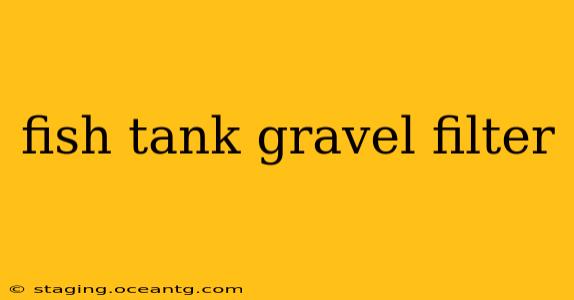Choosing the right filter for your aquarium is crucial for maintaining a healthy environment for your fish. While many opt for traditional canister or hang-on-back filters, understanding the role of fish tank gravel as a filter medium offers a unique perspective on aquarium filtration. This guide will delve into the intricacies of using gravel as a filter, addressing common questions and misconceptions.
What is a Fish Tank Gravel Filter?
A gravel filter, unlike a dedicated canister or hang-on-back filter, utilizes the aquarium's substrate—the gravel or sand—as part of the biological filtration process. It doesn't replace a primary filter; rather, it acts as a supplementary filtration method. The concept revolves around beneficial bacteria colonizing the gravel's surface, breaking down harmful ammonia and nitrite into less toxic nitrate. This process is essential for maintaining water quality and fish health.
How Does a Fish Tank Gravel Filter Work?
The gravel filter relies on the large surface area provided by the gravel particles. As water percolates through the gravel bed, waste products from fish and uneaten food accumulate. Beneficial bacteria, specifically nitrifying bacteria (Nitrosomonas and Nitrobacter), establish themselves on the gravel's surface. These bacteria convert toxic ammonia (produced by fish waste) into nitrite, and then nitrite into nitrate. Nitrate, while still a waste product, is significantly less toxic and can be controlled through regular water changes.
The effectiveness of a gravel filter is directly related to the size and type of gravel used. Larger gravel provides better water flow, while smaller gravel offers a larger surface area for bacterial colonization. A balanced approach is crucial—too small, and water flow can be restricted; too large, and surface area for bacteria will be limited.
What are the Advantages of Using a Gravel Filter?
- Enhanced Biological Filtration: It adds another layer of biological filtration, reducing the workload on your primary filter and promoting a more stable aquarium ecosystem.
- Natural Appearance: It contributes to a more natural and aesthetically pleasing aquarium environment, as it's integrated into the substrate rather than being a separate piece of equipment.
- Cost-Effective: It's a low-cost addition to your filtration system, as you're already using gravel in your tank.
What are the Disadvantages of Using a Gravel Filter?
- Limited Filtration Capacity: It's not a replacement for a primary filter, and its capacity is significantly lower compared to dedicated filters.
- Cleaning Challenges: Cleaning a gravel filter requires careful siphoning to avoid disturbing the beneficial bacteria. Over-cleaning can disrupt the nitrogen cycle, leading to ammonia spikes and potential fish loss.
- Potential for Anaerobic Zones: If the gravel bed is too deep or water flow is insufficient, anaerobic zones (areas with no oxygen) can develop, leading to the production of harmful gases.
Does a Gravel Filter Need a Dedicated Undergravel Filter Plate?
While undergravel filters (UGFs) were once popular, they have largely fallen out of favor due to maintenance difficulties and the potential for anaerobic zones. Modern filtration systems are generally much more efficient and easier to manage. While an undergravel plate can improve water flow through the gravel, it's not strictly necessary for utilizing gravel as a supplementary biological filter. Focusing on proper gravel depth, water flow, and regular maintenance is far more critical.
How Do I Clean a Gravel Filter?
Cleaning a gravel filter requires a gentle approach. Avoid completely replacing the gravel unless absolutely necessary. Instead, use a gravel vacuum to carefully siphon out debris from the top layers of the substrate, being mindful not to disturb the deeper layers where the majority of beneficial bacteria reside. Performing smaller, more frequent water changes also reduces the load on the biological filter and minimizes the need for extensive gravel cleaning.
Is a Gravel Filter Enough for My Fish Tank?
No, a gravel filter alone is insufficient for most aquariums. It should always be used in conjunction with a primary filter (canister, hang-on-back, or sponge filter) to provide adequate mechanical, biological, and chemical filtration. The gravel filter provides supplementary biological filtration, contributing to overall water quality, but it cannot handle the entire filtering load on its own.
This comprehensive guide should provide a clearer understanding of fish tank gravel filters and their role in a healthy aquarium environment. Remember, responsible aquarium management requires a multifaceted approach to filtration, with gravel filtration acting as a valuable but supplementary component.
